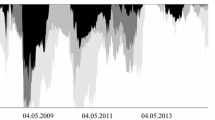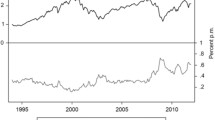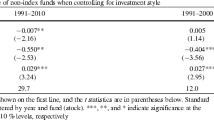Abstract
This article studies the impact of market climate on the classic Jensen alpha (JA) of equity funds. We show analytically that the one-factor JA of a fund consists of (i) the fund’s alpha based on the assumed multi-factor model driving fund returns and (ii) further components that are subject to time-dependent market phases of factor realizations. In our empirical study, we analyze JAs and respective fund rankings for a survivorship bias-free data set of 3102 US equity mutual funds. Our results show that factor realizations during the specific lifetime of a fund clearly affect its JA and rank position. This impact of factor realizations is particularly strong for funds with shorter lifetimes. To quantify the market climate impact, we compare classic JAs of funds with their time period-adjusted JAs, removing the influences of market phases. Finally, our main results are robust when applying alternative multi-factor models as return generating process of funds.




Similar content being viewed by others
Notes
Alternatively, even longer time periods could be considered to estimate ‘normal’ factor alphas that contain no market climate impact (compare, for example, Pastor and Stambaugh, 2002a; Krimm et al, 2012). Next to this time-period adjustment of the JA, it is possible to take advantage of an improvement in the significance of measured alpha which results from a joint estimation of the four-factor model in a Bayesian framework (Stambaugh, 1997; Pastor and Stambaugh, 2002b). We thank an anonymous reviewer for this suggestion.
We choose funds with the following Lipper objective codes: Capital appreciation funds (CA), equity income funds (EI), growth funds (G), growth and income funds (GI), mid-cap funds (MC), and small-cap funds (SG). For fund selection, we rely on the most recent objective code.
Since each fund has at least 36 months of monthly returns, no funds disappeared in the first 3 years and no new funds started after January 2007.
The monthly factor and T-bill returns are downloadable from Kenneth French’s Website (mba.tuck.dartmouth.edu/pages/faculty/ken.french/data_library.html), which also contains information about the factor construction.
We use Newey and West (1987) corrected standard errors that account for heteroskedasticity and autocorrelation when testing the significance of the coefficients.
Monthly returns of the liquidity factor are downloadable from Lubos Pastor’s Website (faculty.chicagobooth.edu/lubos.pastor/research/). Monthly returns of the BAB factor and the QMJ factor can be downloaded from Andrea Frazzini’s Website (www.econ.yale.edu/~af227/data_library.htm). Both Websites also contain information about the respective factor construction.
References
Amihud, Y. and Goyenko, R. (2013) Mutual fund’s R2 as predictor of performance. Review of Financial Studies 26 (3): 667–694.
Aragon, G.O. and Ferson, W.E. (2006) Portfolio performance evaluation. Foundations and Trends in Finance 2 (2): 83–190.
Asness, C.S., Frazzini, A. and Pedersen, L.H. (2014) Quality minus junk. Working paper. Greenwich, U.S.: AQR capital management.
Barber, B.M., Huang, X. and Odean, T. (2015) Which risk factors matter to investors? Evidence from mutual fund flows. Working paper. Davis, U.S.: University of California, East Lansing; U.S.: Michigan State University, Berkeley; U.S.: University of California.
Berk, J.B. and van Binsbergen, J.H. (2016) Assessing asset pricing models using revealed preference. Journal of Financial Economics 119 (1): 1–23.
Berkowitz, M.K. and Kotowitz, Y. (2000) Investor risk evaluation in the determination of management incentives in the mutual fund industry. Journal of Financial Markets 3 (4): 365–387.
Blake, D. and Timmermann, A. (1998) Mutual fund performance: Evidence from the UK. European Finance Review 2 (1): 57–77.
Bodie, Z., Kane, A. and Marcus, A.J. (2014) Investments, Berkshire, UK: McGraw-Hill.
Bollen, N.P.B. and Whaley, R.E. (2009) Hedge fund risk dynamics: Implications for performance appraisal. Journal of Finance 64 (2): 985–1035.
Breloer, B., Scholz, H. and Wilkens, M. (2014) Performance of international and global equity mutual funds: Do country and sector momentum matter? Journal of Banking and Finance 43: 58–77.
Brown, S.J. and Goetzmann, W.N. (1995) Performance persistence. Journal of Finance 50 (2): 679–698.
Carhart, M.M. (1997) On persistence in mutual fund performance. Journal of Finance 52 (1): 57–82.
Carhart, M.M., Carpenter, J.N., Lynch, A.W. and Musto, D.K. (2002) Mutual fund survivorship. Review of Financial Studies 15 (5): 1439–1463.
Comer, G., Larrymore, N. and Rodriguez, J. (2009) Controlling for fixed-income exposures in portfolio evaluation: Evidence from hybrid mutual funds. Review of Financial Studies 22 (2): 481–507.
Elton, E.J., Gruber, M.J. and Blake, C.R. (1996) Survivorship bias and mutual fund performance. Review of Financial Studies 9 (4): 1097–1120.
Evans, R. (2010) Mutual fund incubation. Journal of Finance 65 (4): 1581–1611.
Fama, E.F. and French, K.R. (1993) Common risk factors in the returns on stocks and bonds. Journal of Financial Economics 33 (1): 3–56.
Frazzini, A. and Pedersen, L.H. (2014) Betting against beta. Journal of Financial Economics 111 (1): 1–25.
Goetzmann, W., Ingersoll, J., Spiegel, M. and Welch, I. (2007) Portfolio performance manipulation and manipulation-proof performance measures. Review of Financial Studies 20 (5): 1503–1546.
Jensen, M.C. (1968) Problems in selection of security portfolios. Journal of Finance 23 (2): 389–419.
Krimm, S., Scholz, H. and Wilkens, M. (2012) The Sharpe ratio’s market climate bias: Theoretical and empirical evidence from U.S. equity mutual funds. Journal of Asset Management 13 (4): 227–242.
Malkiel, B.G. (1995) Returns from investing in equity mutual funds 1971 to 1991. Journal of Finance 50 (2): 549–572.
Newey, W.K. and West, K.D. (1987) A simple, positive semi-definite, heteroskedastisity and autocorrelation consistent covariance matrix. Econometrica 55 (3): 703–708.
Pastor, L. and Stambaugh, R.F. (2002a) Mutual fund performance and seemingly unrelated assets. Journal of Financial Economics 63 (3): 315–349.
Pastor, L. and Stambaugh, R.F. (2002b) Investing in equity mutual funds. Journal of Financial Economics 63 (3): 351–380.
Pastor, L. and Stambaugh, R.F. (2003) Liquidity risk and expected stock returns. Journal of Political Economy 111 (3): 642–685.
Rohleder, M., Scholz, H. and Wilkens, M. (2011) Survivorship bias and mutual fund performance: Relevance, significance, and methodical differences. Review of Finance 15 (2): 441–474.
Sharpe, W.F. (1966) Mutual fund performance. Journal of Business 39 (1): 119–138.
Sharpe, W.F. (1994) The Sharpe ratio. Journal of Portfolio Management 21 (Fall): 49–58.
Stambaugh, R.F. (1997) Analyzing investments whose histories differ in length. Journal of Financial Economics 45 (3): 285–331.
Treynor, J.L. and Black, F. (1973) How to use security analysis to improve portfolio selection. Journal of Business 46 (1): 66–88.
Zhao, X. (2005) Exit decisions in the US mutual fund industry. Journal of Business 78 (4): 1365–1401.
Acknowledgements
The authors are grateful to participants of the CFR Research Seminar of the University of Cologne 2008; the SWFA Annual Meeting 2008, Houston; the EFA Annual Meeting 2008, St Pete Beach; the 2008 FMA Annual Meeting, Dallas; the Annual Meeting of the German Finance Association 2008, Münster; the Annual Meeting of the German Academic Association for Business Research 2009, Nürnberg; the Southern Finance Association Annual Meeting 2009, Captiva Island; and, especially to Oliver Entrop, Alexander Kempf, Peter Lückoff, Oliver Schnusenberg, John Stowe, Marco Wilkens and Wenjuan Xie for helpful comments and suggestions on earlier drafts of this paper previously titled ‘Ranking of equity mutual funds: The bias in using survivorship bias-free datasets’. Views expressed in the article are the authors’ own and do not necessarily reflect those of Robeco. We are responsible for any remaining errors.
Author information
Authors and Affiliations
Rights and permissions
About this article
Cite this article
Breloer, B., Lea Hühn, H. & Scholz, H. Jensen alpha and market climate. J Asset Manag 17, 195–214 (2016). https://doi.org/10.1057/jam.2016.4
Received:
Revised:
Published:
Issue Date:
DOI: https://doi.org/10.1057/jam.2016.4




